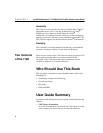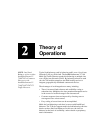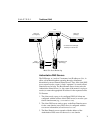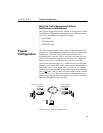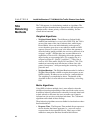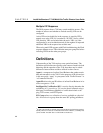
C H A P T E R 2Intel® NetStructure™ 7190 Multi-Site Traffic Director User Guide
10
Site
Balancing
Methods
The 7190 supports six site-balancing methods or algorithms. The
operator chooses the method most appropriate to the deployment to
optimize traffic volume, priority, resource availability, and the
overall desired outcome.
Weighted Algorithms
• Weighted Round Robin - Two differences distinguish this
method from traditional, or round robin, DNS. First, the 7190 is
aware of the status of the sites it balances thus, unlike legacy
Round Robin, it does not indiscriminately send requests to
servers that have gone down or are otherwise unable to fulfill
requests. Second, weighted round robin allows the operator to
skew the loading among available site services on the basis of an
assigned “weight.” (Weight takes into account differences in
capabilities of site services.) Weighting allows the operator to
adjust loading on a percentage basis. For example, Site A is
assigned a weight of 1, Site B, 2, and Site C, 7. Thus, Site A
receives 10% of the traffic, Site B, 20% and Site C, 70%. This
method can ensure the most efficient use of those sites with
greater “horsepower,” while preventing the overtaxing of less
powerful ones.
• Weighted Random - The Weighted Random method is similar to
Weighted Round Robin with the exception that requests are not
fulfilled serially. IP addresses are resolved in a random fashion.
The weighting is accomplished as above. The benefit of this
algorithm is that it is more effective at normalizing, or leveling,
load.
Metric Algorithms
Using DNS to balance multiple sites is more effective when the
referrals are based upon knowledge of the actual loads on the servers.
In addition, balancing effectiveness noticeably increased when back-
to-back referrals to the same site were not made even if metrics
indicated one site service was the best both times. The 7190 metric
algorithms reflect both of those findings.
These balancing algorithms are not available for sites that do not have
Intel load balancers:
• Response Time - The Response Time method directs requests to
the site that has the fastest aggregate (i.e., across all servers)
response time for the requested service. Likely users of this
method are enterprises that have identified the efficient



